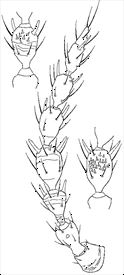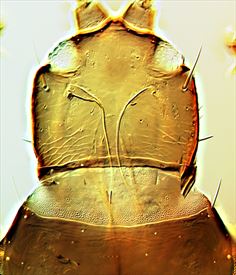
Antenna of aptera

Antenna of macroptera

Antennal sense cones

Head

Pelta & tergite II

Male sternite VIII pore plate
Distinguishing features
Female fully winged or apterous. Body pale brown; distal half of antennal segment II, most of segment III, tarsi, and tibiae yellow; tube darker medially; fore wings and major setae pale. Head wider than long, expanded behind eyes, slightly constricted at base, with faint lines of sculpture basally; postocular setae blunt, wide apart; maxillary stylets about one-fifth of head width apart medially, reaching to postocular setae. Antennal segment III with pedicel bearing transverse lines of sculpture, IV–VII each with a distinct pedicel; segment III with 2 sense cones, IV with 2, 3, or 4 (i.e., 2 large or 4 small); segment IV enlarged, ventral surface on distal half with up to 25 small sense cones; segments V and VI with similar but fewer sense cones ventrally; segment VIII scarcely constricted at base. Pronotum with very little sculpture; anteromarginal setae minute, remaining major setae blunt or weakly expanded; basantra absent. Mesopresternum boat-shaped; metathoracic sternopleural sutures short; metanotum with striate sculpture laterally, median setal pair acute, 1 or 2 smaller pairs anterior to these. Fore tarsal tooth small. Fore wings with 8–10 duplicated cilia; major sub-basal setae blunt to acute, S1 and S2 longest. Pelta faintly sculptured; tergites II–VII each with 2 pairs of curved wing-retaining setae; tergite IX posteromarginal setae S1 blunt to expanded, about half as long tube. Female aptera similar but compound eyes smaller; ocelli absent; stylets closer together; antennal segment IV scarcely enlarged, its ventral surface bearing less than 4 small sense cones; mesonotum and metanotum transverse; pelta broader; tergites II–VII each with 2 pairs of small, straight wing-retaining setae.
Male aptera. Largely brownish yellow, but tube, pronotum, and distal antennal segments darker. Similar to female but mesopresternum scarcely developed; sternite VIII with an irregular pore plate not reaching to lateral margins; sternites IV–VII with lateral reticulate areas; tergite IX posteromarginal setae S2 shorter. Large males with fore tarsal tooth enlarged, fore femora swollen, and pronotum elongate, with a median longitudinal apodeme.
Related species
The genus Hoplothrips comprises about 130 species worldwide, of which 7 are recorded from New Zealand. Several of these appear to be endemic to this country, but corticis is from the Northern Hemisphere and orientalis is probably from Asia. H. semicaecus is remarkable for the additional small sense cones on antennal segments IV–VI. This species has been considered as introduced to New Zealand, either from Europe or North America, but the considerable structural diversity among New Zealand populations suggests that it originated here and has been dispersed subsequently to the Northern Hemisphere (Mound & Walker, 1986).
Biological data
This species is a fungus-feeder on dead branches.
Distribution data
Described originally from "Bohemia", this species is recorded widely in northern Europe and also north-eastern America. However, it is also widespread in New Zealand (AK, WO, CL, WN / WD, MC, CO / SI / The Snares).
Family name
PHLAEOTHRIPIDAE, PHLAEOTHRIPINAE
Species name
Hoplothrips semicaecus (Uzel)
Original name and synonyms
Trichothrips semicaeca Uzel, 1895: 249
Trichothrips amabilis Bagnall, 1926: 283
Hoplothrips (Trichothrips) fieldsi Crawford JC, 1939: 77
References
Mound LA & Walker AK (1986) Tubulifera (Insecta: Thysanoptera). Fauna of New Zealand 10: 1–140.